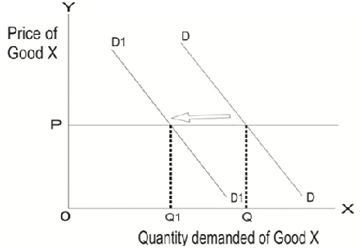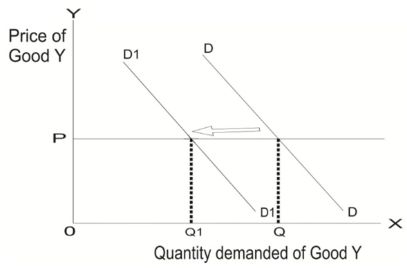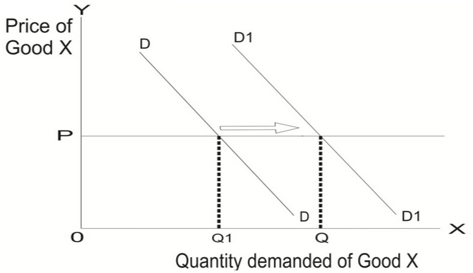
(a)
To explain:
The impact on
Answer to Problem 1CACQ
There will be fall in demand of goods X.
Explanation of Solution
There is a leftward shift in demand curve. This is because when there is decrease in income, it leads to fall in demand. This is because the commodity is normal goods. So, there is a positive relation between demand and income.
In the below diagram, DD is the initial demand curve and P is the

Figure 1: Decrease in the income of consume shifts demand curve leftwards
Thus, when income of the consumer decreases, the demand of goods X decreases from Q to Q1 keeping price of goods X fixed.
Normal Goods:
The goods are said to be a normal goods when there is a positive relation between income and demand of a commodity.
Inferior goods:
The goods are said to be inferior goods when there is an inverse relation between income and demand of a commodity.
(b)
To explain:
The impact on demand for goodsY due to increase in income.
Answer to Problem 1CACQ
There will be fall in demand of goodsY.
Explanation of Solution
There is a leftward shift in demand curve. This is because when there is increase in income, it leads to fall in demand as goods is an inferior goods. So, there is an inverse relation between demand and income, thus decreasing the demand of inferior goods.
In the below diagram, DD is the original demand curve, P is the initial price line. As income of a consumer increases, it leads to leftward shift of demand curve from DD to D1. This is because goods in question is an inferior goods.
Figure 2: Increase in the income of consumer shifts demand curve of Goods Y (Inferior Goods) leftwards

Thus, when income of the consumer increases, the demand of goods Y decreases from Q to Q1 keeping price of goods Y fixed.
Normal Goods:
The goods are said to be a normal goods when there is a positive relation between income and demand of a commodity.
Inferior goods:
The goods are said to be inferior goods when there is an inverse relation between income and demand of a commodity.
(c)
To explain:
The impact on demand for goods X due to increase in price of goods Y.
Answer to Problem 1CACQ
The demand for goods X increases when price of goods Y increases.
Explanation of Solution
It is given that the goods X and goods Y are substitute goods which mean that consumer can use these goods in place of one another. Substitute goods are those goods which are used in place of each other. Price of goods X leads to increase in demand for goods Y.
Goods are substitutable in nature. Demand of a goods is affected when price of related goods changes.
The diagram given below shows the effect of increase in the price of goods Y on the demand of goods X.
Figure 3: Demand curve of goods X shifts rightwards as price its substitute goods (Goods Y) increases.

In Figure-3, DD is the original demand curve, P is the price line. As there is an increase in price of goods Y, it leads to shift in demand curve from DD to D 1. Therefore, demand for goods X increases when price of goods Y increases.
Substitute goods:
Substitute goods are those which can be used in place of each other. These goods have a positive cross elasticity.
Complementary goods:
Complementary goods are those which are used together. These goods have negative cross elasticity.
(d)
To explain:
Whether goods Y is a lower quality product than goods X.
Answer to Problem 1CACQ
No, quality of goodsY cannot be determined.
Explanation of Solution
Inferior goods do not mean it is of sub-standard quality. The goods are said to be inferior in nature when the relationship between income of consumer and the demanded quantity of goods is indirect.
As income of consumer rises, it leads to decrease in demand of a commodity, this is because, consumer shifts its demand to a goods which is better than the goods consumed.
As income falls, it leads to increase in consumption of a goods. So, quality of goods Y cannot be determined.
Normal Goods:
The goods are said to be a normal goods when there is a positive relation between income and demand of a commodity.
Inferior goods:
The goods are said to be inferior goods when there is an inverse relation between income and demand of a commodity.
Want to see more full solutions like this?
Chapter 2 Solutions
Gen Combo Managerial Economics & Business Strategy; Connect Access Card
- Please help and thanks! (Note: This is a practice problem!)arrow_forwardUnit VI Assignment Instructions: This assignment has two parts. Answer the questions using the charts. Part 1: Firm 1 High Price Low Price High Price 8,8 0,10 Firm 2 Low Price 10,0 3,3 Question: For the above game, identify the Nash Equilibrium. Does Firm 1 have a dominant strategy? If so, what is it? Does Firm 2 have a dominant strategy? If so, what is it? Your response:arrow_forwardnot use ai please don't kdjdkdkfjnxncjcarrow_forward
- Ask one question at a time. Keep questions specific and include all details. Need more help? Subject matter experts with PhDs and Masters are standing by 24/7 to answer your question.**arrow_forward1b. (5 pts) Under the 1990 Farm Bill and given the initial situation of a target price and marketing loan, indicate where the market price (MP), quantity supplied (QS) and demanded (QD), government stocks (GS), and Deficiency Payments (DP) and Marketing Loan Gains (MLG), if any, would be on the graph below. If applicable, indicate the price floor (PF) on the graph. TP $ NLR So Do Q/yrarrow_forwardNow, let us assume that Brie has altruistic preferences. Her utility function is now given by: 1 UB (xA, YA, TB,YB) = (1/2) (2x+2y) + (2x+2y) What would her utility be at the endowment now? (Round off your answer to the nearest whole number.) 110arrow_forward
- Problema 4 (20 puntos): Supongamos que tenemos un ingreso de $120 y enfrentamos los precios P₁ =6 y P₂ =4. Nuestra función de utilidad es: U(x1, x2) = x0.4x0.6 a) Planteen el problema de optimización y obtengan las condiciones de primer orden. b) Encuentren el consumo óptimo de x1 y x2. c) ¿Cómo cambiará nuestra elección óptima si el ingreso aumenta a $180?arrow_forwardPlease draw the graph for number 4 and 5, I appreciate it!!arrow_forwardnot use ai pleasearrow_forward
- not use ai pleasearrow_forward• Prismatic Cards: A prismatic card will be a card that counts as having every suit. We will denote, e.g., a prismatic Queen card by Q*. With this notation, 2.3045 Q would be a double flush since every card is a diamond and a heart. • Wild Cards: A wild card counts as having every suit and every denomination. Denote wild cards with a W; if there are multiple, we will denote them W₁, W2, etc. With this notation, W2 20.30054 would be both a three-of-a-kind (three 2's) and a flush (5 diamonds). If we add multiple wild cards to the deck, they count as distinct cards, so that (e.g.) the following two hands count as "different hands" when counting: W15 5Q and W255◊♡♡♣♣ In addition, 1. Let's start with the unmodified double-suited deck. (a) Call a hand a flush house if it is a flush and a full house, i.e. if all cards share a suit and there are 3 cards of one denomination and two of another. For example, 550. house. How many different flush house hands are there? 2. Suppose we add one wild…arrow_forwardnot use ai pleasearrow_forward
 Economics (MindTap Course List)EconomicsISBN:9781337617383Author:Roger A. ArnoldPublisher:Cengage Learning
Economics (MindTap Course List)EconomicsISBN:9781337617383Author:Roger A. ArnoldPublisher:Cengage Learning









